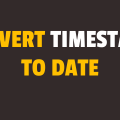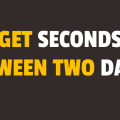How to Get Unix Timestamp in Javascript
In this tutorial, you will learn how to get unix timestamp in javascript. The Unix timestamp is a total number of seconds that have elapsed since January 1st, 1970 at UTC.
The UTC stands for coordinated universal time and it remains the same for everyone no matter where you are in the world. That is why it’s extremely easy for computer systems to convert UTC to your local time.
There are 2 common ways to get Unix timestamp in javascript. One is using Date constructor and another one is by using Date object. However, they return milliseconds instead of seconds so we need to divide the returned value by 1000 to convert it into seconds. We are going to use both of them one by one.
In the following example, we simply want to display Unix timestamp upon click of a button. Please have a look over the code example and steps given below.
HTML & CSS
- We have 3 elements in the HTML file and that includes
div,button, andh1elements. - The
divelement is just a wrapper for the rest of the elements. - The inner text for the
buttonelement is“Get”and for theh1button, it is“Result”. - We have done some basic styling using CSS and added the link to our
style.cssstylesheet inside theheadelement. - We have also included our javascript file
script.jswith ascripttag at the bottom.
<!DOCTYPE html>
<html lang="en">
<head>
<meta charset="UTF-8">
<meta name="viewport" content="width=device-width, initial-scale=1.0">
<meta http-equiv="X-UA-Compatible" content="ie=edge">
<link rel="stylesheet" href="style.css">
<title>Document</title>
</head>
<body>
<div>
<button>Get</button>
<h1>Result</h1>
</div>
<script src="script.js"></script>
</body>
</html>
div {
display: flex;
flex-direction: column;
align-items: center;
}
button{
padding: 10px 20px;
margin-top: 10px;
}
Javascript
- We have selected both the elements
buttonandh1usingdocument.querySelector()and stored them inbtnGetandresultvariables respectively. - We have attached the
clickevent listener to thebuttonelement.
Date Constructor
- In the event handler function, we are using the
Dateconstructor and calling thegetTime()method. ThisgetTime()method returns timestamp in milliseconds and we are storing it incurrentTimestampvariable. - We are converting it into seconds by dividing it by 1000 and avoiding any decimals by passing it as a parameter to the
Math.floor()method.
Date Object
- In the event handler function, we are using the
Dateobject and callingnow()method. Thisnow()method returns timestamp in milliseconds and we are storing it incurrentTimestampvariable. - We are converting it into seconds by dividing it by 1000 and avoiding any decimals by passing it as a parameter to the
Math.floor()method.
let btnGet = document.querySelector('button');
let result = document.querySelector('h1');
btnGet.addEventListener('click', () =>{
// let currentTimestamp = new Date().getTime();
let currentTimestamp = Date.now();
result.innerText = Math.floor(currentTimestamp/1000);
})




